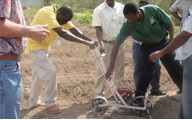
Protecting Lives and Livelihoods from the Impacts of Climate Change
Jamaica continues to be adversely affected by climate change. Unpredictable rainfall patterns with an increasing trend toward extended droughts, temperature increases, and more frequent and intense natural disasters impede the development and growth of the country’s economy. The three-year Jamaica Rural Economy and Ecosystems Adapting to Climate Change (Ja REEACH) project was implemented by ACDI/VOCA and worked to protect rural lives, livelihoods, and ecosystems through interventions that lessened climate change impacts and strengthened the adaptive capacity of vulnerable communities to respond.
Activities and Approaches
- Used the farmer field school (FFS) extension approach to equip farmers with the latest climate-smart agriculture techniques from crop establishment to postharvest handling
- Through climate-change action training, built the capacity of Jamaican youth aged 14-28 to understand the current and expected impacts of climate change, how communities and households must react through adaptation and mitigation, and how young people as action agents can make a difference in raising awareness and implementing projects
- Aided communities in defining climate-driven risks and hazards and developing locally relevant risk reduction action plans and projects that protect their lives and economic activities
Anticipated/Achieved Project Results
- 49,039 person hours of training in climate change awareness delivered to farmers, community groups, students, and project partners to improve the capacity to respond to climate change challenges
- 6,788 project beneficiaries increased their adaptive capacity to respond to climate change and disasters; more than 57 farmer groups (over 1,000 farmers) completed farmer field school sessions that built up their adaptive capacity
- More than 25 extension agents trained in agro-meteorology
- 20 agroforestry demonstration plots and projects established and over 936 farmers applying individual innovations on farm plots
- Over 234 hectares of degraded areas reforested and rehabilitated (including agroforestry innovations in upper watershed areas and the planting of fruit and timber trees)
- 395,035 timber and fruit seedlings distributed to support the reforestation and application of agroforestry programs in degraded upper watershed areas
- 300 farmers graduated from 17 climate-smart agriculture schools in agroforestry and horticulture
- 2,146 youth (ages 25 and under) reached through the project’s training targeted programs; 100 graduated from five climate-change agent training groups
- 756 participants from 13 communities completed CEDAR workshops and worked with Ja REEACH technical officers to prepare climate risk analysis reports and eight climate action plans
- Five communities formed new community disaster risk management groups and developed community disaster risk management plans
- Distributed over 153,000 seedlings
- 14 climate and disaster risk-mitigation plans prepared
- Over 3,851 youths from high schools and community groups are now equipped to address climate change challenges
- 83 percent increase in climate change awareness
- Over 5,074 project beneficiaries now have greater capacity to adapt to the impacts of climate variability and change
- 475 farmers are able to utilize climate services through the agro meteorology farmer forums
- 1,447 risk-reduction actions taken to reduce vulnerability to climate and disaster hazards
- 53 percent increase in knowledge about climate-change solutions in technical trainees
- 147,542 trees were planted in a forest reserve, and 21 agroforestry demonstration plots were established in watershed communities
- Developed and piloted new training tool and processes for climate change capacity building of farmers, community groups, and youth; and trained partners to utilize these tools
- Partnered with local communities and groups to implement risk mitigation measures and promote short-and long term adaptation to climate change





